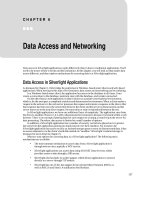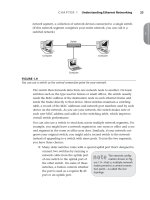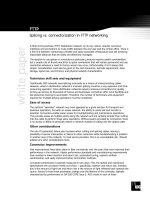VSICM6 m05 networking
Bạn đang xem bản rút gọn của tài liệu. Xem và tải ngay bản đầy đủ của tài liệu tại đây (1.22 MB, 50 trang )
Configuring and Managing Virtual Networks
Module 5
© 2015 VMware Inc. All rights reserved.
You Are Here
9.
7.
Virtual Machine Management
10. Software-Defined Data Center
8.
Resource Management and Monitoring
11.
9.
vSphere HA and vSphere Fault Tolerance
Course Introduction
Creating Virtual Machines
12. vCenter Server
10. Host Scalability
13. Configuring and Managing Virtual Networks
11.
14. Configuring and Managing Virtual Storage
12. Installing vSphere Components
vSphere Update Manager and Host Maintenance
Insert Course Title Here – Prerelease
© 2015 VMware Inc. All rights reserved.
?-2
Importance
VMware ESXi™ networking features enable:
•
Virtual machines to communicate with other virtual and physical machines
•
Management of the ESXi host
•
VMkernel communication on the network
Failure to properly configure ESXi networking can negatively affect virtual machine management and storage operations.
Insert Course Title Here – Prerelease
© 2015 VMware Inc. All rights reserved.
?-3
Module Lessons
Lesson 1:
Introduction to vSphere Standard Switches
Lesson 2:
Configuring Standard Switch Policies
Lesson 3:
Introduction to vSphere Distributed Switches
Insert Course Title Here – Prerelease
© 2015 VMware Inc. All rights reserved.
?-4
Lesson 1:
Introduction to vSphere Standard Switches
?-5
© 2015 VMware Inc. All rights reserved.
Learner Objectives
By the end of this lesson, you should be able to meet the following objectives:
•
Describe the virtual switch connection types
•
Describe the components of a standard switch
Insert Course Title Here – Prerelease
© 2015 VMware Inc. All rights reserved.
?-6
Types of Virtual Switch Connections
A virtual switch has specific connection types:
ã
Virtual machine port groups
ã
VMkernel port:
For IP storage, VMware vSpheređ High Availability, VMware vSphere® vMotion® migration, VMware vSphere® Fault Tolerance, VMware Virtual
SAN™, and VMware vSphere® Replication™
–
For the ESXi management network
Virtual Machine Port Groups
Production
TestDev
VMkernel Ports
DMZ
vSphere vMotion
Management
Virtual Switch
Uplink Ports
Insert Course Title Here – Prerelease
© 2015 VMware Inc. All rights reserved.
?-7
Virtual Switch Connection Examples
More than one network can coexist on the same virtual switch. Or networks can exist on separate virtual switches.
Management
vSphere vMotion
Production
TestDev
iSCSI
Virtual Switch
Management
Virtual
Virtual Switch
Switch
vSphere vMotion
Virtual
Virtual Switch
Switch
Production
Virtual
Virtual Switch
Switch
TestDev
Virtual
Virtual Switch
Switch
Insert Course Title Here – Prerelease
© 2015 VMware Inc. All rights reserved.
iSCSI
Virtual
Virtual Switch
Switch
?-8
Types of Virtual Switches
A virtual network supports these types of virtual switches:
•
Standard switches:
–
•
Virtual switch configuration for a single host
Distributed switches:
–
Virtual switches that provide a consistent network configuration for virtual machines as they migrate across multiple hosts
Insert Course Title Here – Prerelease
© 2015 VMware Inc. All rights reserved.
?-9
Standard Switch Components
A standard switch provides connections for virtual machines to communicate with one another, whether they are on the same
host or a different host.
VM1
VNIC
VM2
VNIC
VM3
VNIC
IP
Management
storage
Network
VNIC
VMkernel
VMkernel
Test VLAN 101
Production VLAN 102
IP Storage VLAN 103
Management VLAN 104
Insert Course Title Here – Prerelease
© 2015 VMware Inc. All rights reserved.
?-10
Viewing the Standard Switch Configuration
You can view a host’s standard switch configuration by clicking Networking on the Manage tab.
Display port group properties.
Delete the port group.
Display Cisco Discovery Protocol information.
Insert Course Title Here – Prerelease
© 2015 VMware Inc. All rights reserved.
?-11
About VLANs
ESXi supports 802.1Q VLAN tagging.
VM
VM
Virtual switch tagging is one of the tagging policies supported:
•
Packets from a virtual machine are tagged as they exit the virtual
switch.
•
Packets are untagged as they return to the virtual machine.
•
Effect on performance is minimal.
VMkernel
VLAN
VLAN 105
105
VLAN
VLAN 106
106
Virtual
Virtual Switch
Switch
ESXi provides VLAN support by giving a port group a VLAN ID.
Physical NIC
Physical Switch
Trunk Port
Insert Course Title Here – Prerelease
© 2015 VMware Inc. All rights reserved.
?-12
Network Adapter Properties
A physical adapter can become a bottleneck for network traffic if the adapter speed does not match application requirements.
Insert Course Title Here – Prerelease
© 2015 VMware Inc. All rights reserved.
?-13
Review of Learner Objectives
You should be able to meet the following objectives:
•
Describe the virtual switch connection types
•
Describe the components of a standard switch
Insert Course Title Here – Prerelease
© 2015 VMware Inc. All rights reserved.
?-14
Lesson 2:
Configuring Standard Switch Policies
?-15
© 2015 VMware Inc. All rights reserved.
Learner Objectives
By the end of this lesson, you should be able to meet the following objectives:
•
Describe the security of a standard switch port group
•
Describe the traffic shaping of a standard switch port group
•
Describe the NIC teaming and failover of a standard switch port group
Insert Course Title Here – Prerelease
© 2015 VMware Inc. All rights reserved.
?-16
Network Switch and Port Policies
Policies set at the standard switch level apply to all of the port groups on the standard switch. The exceptions are the
configuration options that are overridden at the standard port group.
Available network policies:
•
•
•
Security
Traffic shaping
NIC teaming and failover
Policies are defined at these levels:
•
Standard switch level:
–
•
Default policies for all the ports on the standard switch.
Port group level:
–
Effective policies: Policies defined at this level override the default policies set at the standard switch level.
Insert Course Title Here – Prerelease
© 2015 VMware Inc. All rights reserved.
?-17
Configuring Security Policy
Administrators can define security policies at both the standard switch level and the port group level:
•
Promiscuous mode: Allows a virtual switch or port group to present all traffic regardless of the destination.
•
MAC address changes: Accept or reject inbound traffic when the MAC address has been altered by the guest.
•
Forge transmits: Accept or reject outbound traffic when the MAC address has been altered by the guest.
Insert Course Title Here – Prerelease
© 2015 VMware Inc. All rights reserved.
?-18
Traffic-Shaping Policy
Network traffic shaping is a mechanism for limiting a virtual machine’s consumption of available network bandwidth.
Average rate, peak rate, and burst size are configurable.
Outbound Bandwidth
Peak Bandwidth
Average
Time
Burst Size = Bandwidth x Time
Insert Course Title Here – Prerelease
© 2015 VMware Inc. All rights reserved.
?-19
Configuring Traffic Shaping
A traffic-shaping policy is defined by average bandwidth, peak bandwidth, and burst size. You can establish a traffic-shaping
policy for each port group and each distributed port or distributed port group:
•
Traffic shaping is disabled by default.
•
Parameters apply to each virtual NIC in the standard switch.
•
On a standard switch, traffic shaping controls only outbound traffic.
Insert Course Title Here – Prerelease
© 2015 VMware Inc. All rights reserved.
?-20
NIC Teaming and Failover Policy
Administrators can edit the NIC teaming and failover policy by configuring specific options.
Insert Course Title Here – Prerelease
© 2015 VMware Inc. All rights reserved.
?-21
Load-Balancing Method: Originating Virtual Port ID
The diagram shows routing based on the originating port ID, called virtual port ID load balancing.
Virtual
Switch
Physical
Switch
Virtual NICs
Physical NICs
Insert Course Title Here – Prerelease
© 2015 VMware Inc. All rights reserved.
?-22
Load-Balancing Method: Source MAC Hash
The diagram shows routing based on source MAC hash.
Internet
Virtual
Switch
Physical
Switch
Virtual
Physical
NICs
NICs
Insert Course Title Here – Prerelease
© 2015 VMware Inc. All rights reserved.
?-23
Load-Balancing Method: Source and Destination IP Hash
The diagram shows routing based on IP hash.
Internet
Virtual NICs
Virtual
Physical
Switch
Switch
Physical NICs
Insert Course Title Here – Prerelease
© 2015 VMware Inc. All rights reserved.
?-24
Detecting and Handling Network Failure
The VMkernel can use link status or beaconing or both to detect a network failure.
Network failure is detected by the VMkernel, which monitors the link state and performs beacon probing.
VMkernel notifies physical switches of changes in the physical location of a MAC address.
Failover is implemented by the VMkernel based on configurable parameters:
•
•
Failback: How the physical adapter is returned to active duty after recovering from failure.
Load-balancing option: Use explicit failover order. Always use the vmnic uplink at the top of the active adapter list.
Insert Course Title Here – Prerelease
© 2015 VMware Inc. All rights reserved.
?-25









